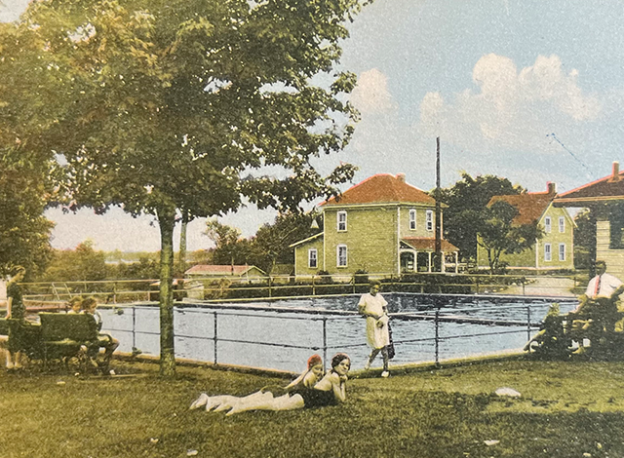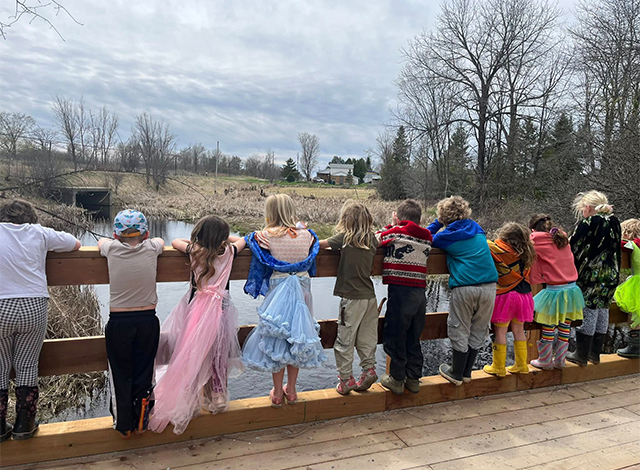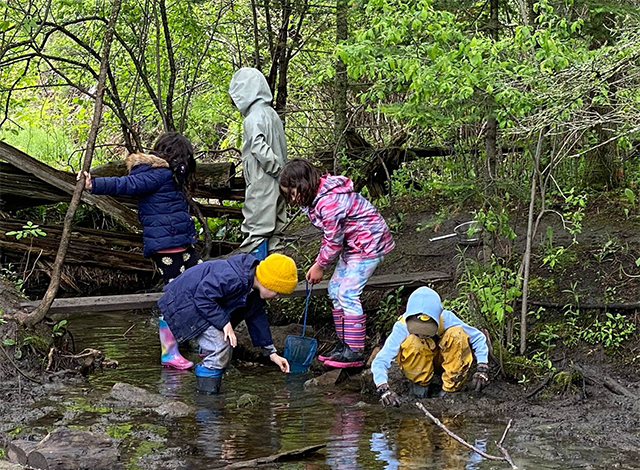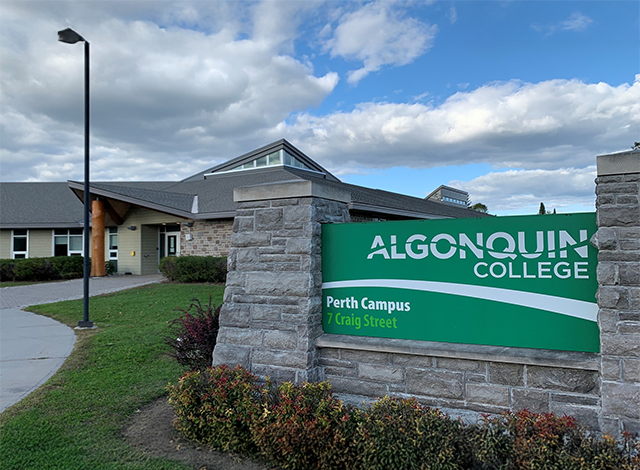Evening strolls through Victoria Park often lead to a large stone adorned with a bronze marker laid in 1923. The marker reads “This swimming pool erected by the corporation and citizens of Smiths Falls under the auspices of the Rotary Club”. Antique postcards featuring beautiful images of the Rotary Pool are relatively common. An old black and white film produced in the 1930s, includes footage of happy children diving, splashing, swimming, and playing poolside—but where is the pool?
I have practiced the art of magic and illusion for forty-five years. I can levitate my beautiful wife Marion in the air with ease. I divide her into two pieces and restore her on a regular basis. On a really good day, I can even vanish from the stage where I am performing and reappear in the middle of the audience. When I realized that a massive concrete swimming pool just down the street from our house had vanished, my attention was piqued. I began consulting old newspapers and made some phone calls. Here is what I discovered.
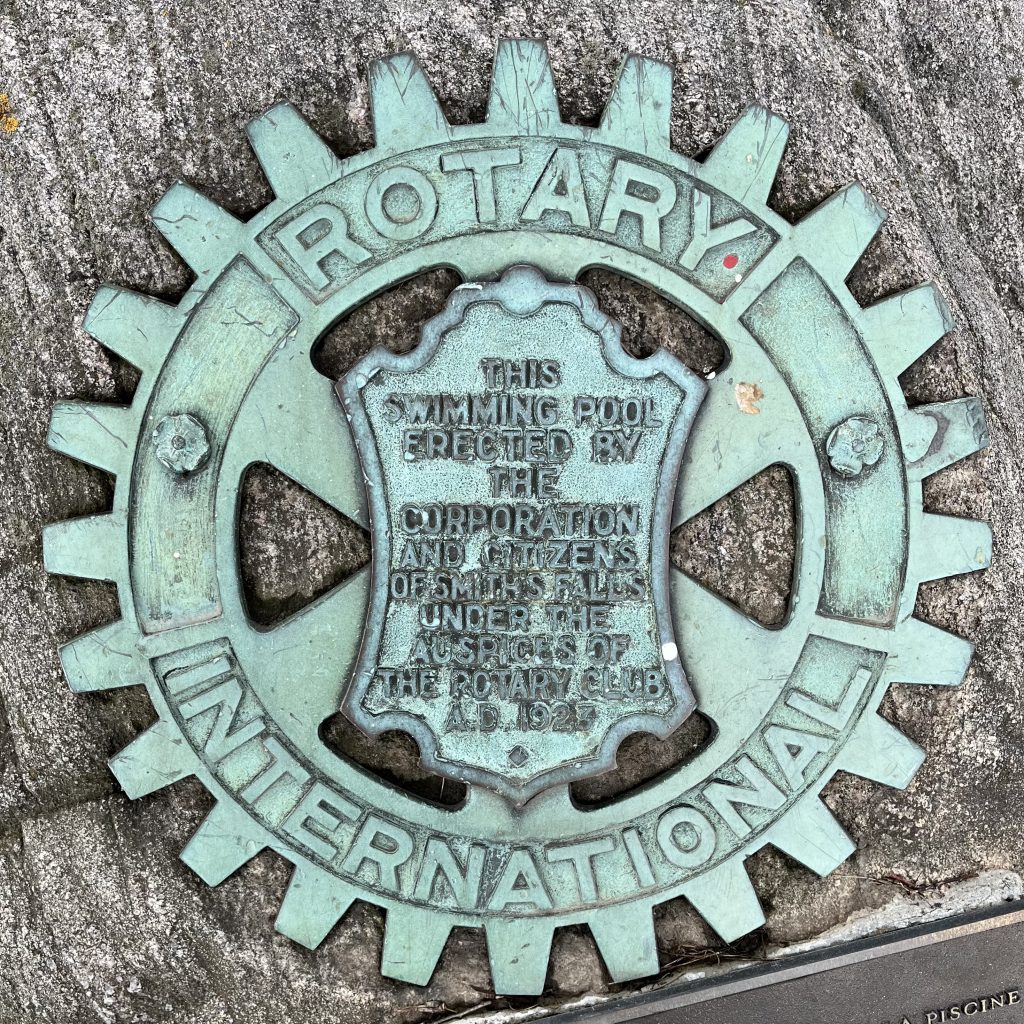
Photo credit: Ted Outerbridge.
The Rotary Club of Smiths Falls was chartered as the 1189th club in 1922. It was unique at the time as it was the only group in town that permitted men of different denominations to meet socially. It was a service club that provided fellowship, networking opportunities, and a chance to engage in public service—but unlike the Freemasons and other organizations active at that time, without secrecy and bizarre rituals. Within a year of being organized, they had built a very impressive public swimming pool for the town. A pool house with separate changing rooms for men and women stood beside it. The attraction was built on Wood Island east of Beckwith Street and north of Canal Street, across from the War Memorial Cenotaph. In A History of the Smiths Falls Lock Stations, 1827-1978 Peter DeLottinville tells us that this site was formerly Robert Wesley Joynt’s blacksmith shop.
Swimming in the Rideau Canal can present many dangers. In 1923, when the community could finally swim safely in a luxurious swimming pool, it was cause for celebration. The Rotary Club employed two swimming instructors and a lifeguard. The caretaker was employed by the town. Children and adults alike received the benefits swimming can deliver including the self-confidence of progressing through different levels of swimming lessons. Many beautiful childhood summertime memories were born at the Rotary Pool. Opposite the pool were sandboxes, swings, and a playground. Swimming classes took place every morning and a 4-year-old Jean McNeill was likely one of the first students. Her father was Stanley McNeill, manager of the Rideau Theatre, later the Capitol Theatre. Her grandmother was Alice McNeill who lived just down the street at the Keyhole House.
Ron Stronski is a well-known personality who says he grew up at the Rotary Pool. He remembers that the pool had two sections with a concrete divider separating the boys from the girls. “The lifeguards were high school students, and they could walk along the divider,” Ron explained. On several occasions Ron “accidentally” found himself in the girl’s section which resulted in his being sent home for the day, in a state of devastation. He explained that the pool was fed by the Rideau Canal and water entered through steel grates and then discharged into the canal behind the pool. “The pool was tremendously popular with kids. It was extremely well maintained and there were sandboxes, benches and at least 15 swings on the property.” Ron reminisced. He would return at night and sit on the swings facing the Frost & Wood plant. He loved to watch the bright blue flames produced by the forging facilities which would dance and reflect on the Rideau Canal.
The Ottawa Journal reported that in 1953, the steady expansion of Smiths Falls had caused the Rotary Pool to become too congested. Another site had to be found. “The pool had become outdated.” Ron Stronski added. After 30-years of service, the pool was retired and filled in with earth. A photograph from the Francis Minnie collection taken in the mid-1950s documents the outline of the pool in the park after it had been filled in.
The Water Commission moved an intake pipe to make a long stretch of water on the canal, near the centre of town, safe for swimming. 525 truckloads of rock and sand poured into a cribwork of logs resulted in 400 feet of sandy beach. The new Smiths Falls Municipal Pool opened on Coronation Day, June 2, 1953. The new site was at the foot of George Street in Hydro Park, now known as Murphy Park. The well-equipped facility continues to generate beautiful summertime memories to this day.
Ted & Marion Outerbridge are currently restoring the Keyhole House, a Smiths Falls heritage home built in 1893. They are also being swept away by local history & mystery. You can follow them on Instagram, Facebook, and TikTok @thekeyholehouse or email ted@tedouterbridge.com.

